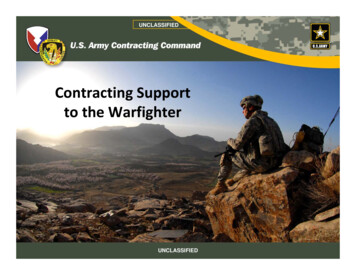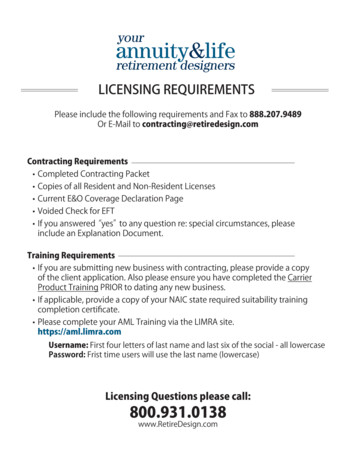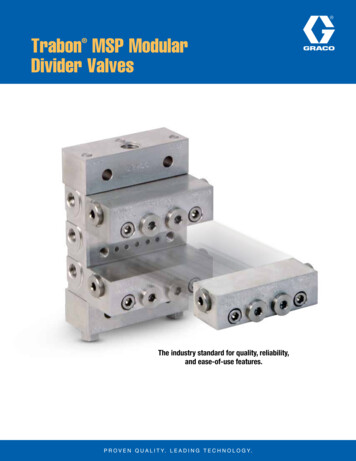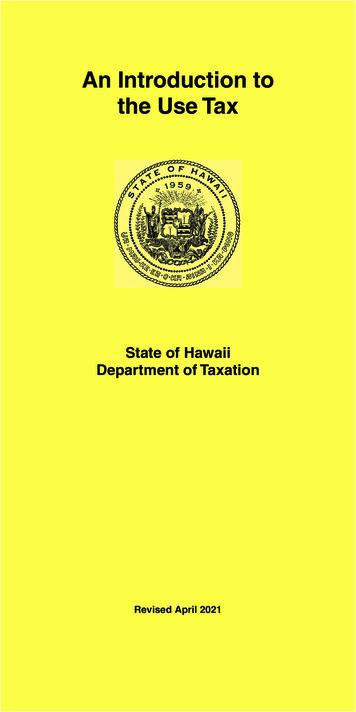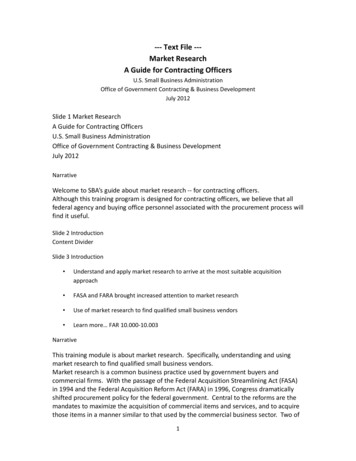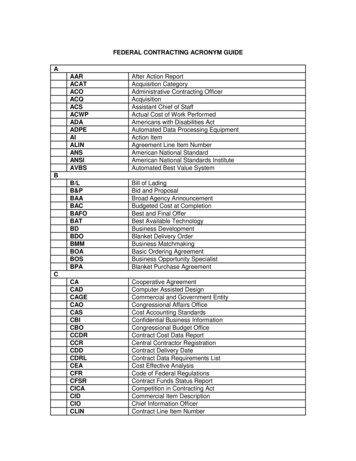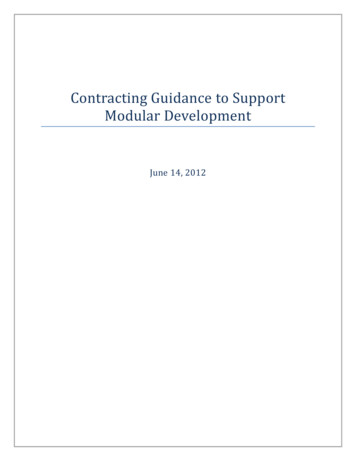
Transcription
Contracting Guidance to SupportModular DevelopmentJune 14, 2012
CONTRACTING GUIDANCE TO SUPPORT MODULAR DEVELOPMENTTable of ContentsI.Purpose and Scope . 2II.Overview. 2III. Background . 3IV. Modular Development: Key Terms, Principles and Risks . 6A.IT Investment . 6B.Projects and activities . 7C.Key Principles . 9D.Risk and Challenges in Modular Development . 9Modular Contracting for IT: Tools and Strategies. 10V.A.Contracting Approaches Suitable for Modular Development . 10B.Payment Strategies . 16C.Use of Competition . 19D.Provisions and Clauses . 20E.Additional Acquisition Considerations. 21VI. Appendix: Sample Performance Work Statement. 23 1
CONTRACTING GUIDANCE TO SUPPORT MODULAR DEVELOPMENTPurpose and ScopeI.The purpose of this guidance is to provide agencies with contracting guidance to support modulardevelopment, as required by Information Technology (IT) Reform Action 15: Issue Contracting Guidanceand Templates to Support Modular Development, 25 Point Implementation Plan to Reform FederalInformation Technology Management.1 This guidance presents a variety of factors that contractingofficers, in support of IT managers, will need to consider as they plan for modular development efforts,such as whether to award to a single vendor or multiple vendors; how to ensure that there isappropriate competition at various stages in the process; how broad or specific the statements of workshould be; when to use fixed-price contracts or rely on other pricing arrangements; and how to promoteopportunities for small business.2 It also empowers agency leadership and Integrated Project Teams(IPTs)3 with strategies and tools to improve investment manageability and budgetary feasibility, reduceoverall risk, and support rapid delivery of workable solutions. This document is not intended to providecomprehensive guidance concerning a development methodology or standards for a modular softwaredevelopment lifecycle; rather, it is primarily focused on outlining acquisition guidance to supportmodular development approaches.OverviewII.As outlined in the 25 Point Implementation Plan to Reform Federal Information TechnologyManagement4, Federal agencies have traditionally taken a multi-year “grand design” approach fordeveloping, modernizing, and enhancing investments in IT. This approach is grounded in the commonnotion that responsible development necessitates a full detailing of requirements before work can start.Although a seemingly reasonable assumption, practical evidence and private sector experience hasshown that large and complex IT implementations often encounter cost and schedule overruns, as thepainstaking process of requirements gathering too frequently takes years to complete. Subsequently,agencies lose visibility into the performance of these multi-year IT development investments whichaffects their ability to implement corrective actions that reduce risk or mitigate financial exposure. TheGovernment increases investment risk in these situations because: (1) the IT solutions that had onceaddressed agency requirements may no longer be pertinent or a priority; (2) substantial funds areallocated towards outdated solutions without any returns on the investments; or (3) agencies encounterbudgetary constraints before substantive work is completed.To help resolve these issues, modular approaches should be used in the development of IT investments,allowing agencies to implement significant capabilities for investments through the use of modularsolutions that can be defined, developed, and deployed within months instead of several years. Thisguidance highlights critical success factors for adopting modular approaches, including the need tostrengthen collaboration among agency IT, program, acquisition, and finance offices in order to design,resource, and manage investments in a modular fashion. To ensure successful collaboration across theseoffices, it is important to have a common and consistent vocabulary for key modular IT and acquisition125 Point Implementation Plan to Reform Federal IT Management: on-Plan-to-ReformFederal%20IT.pdf2Ibid.3OMB Capital Programming Guide, June 2006, page b/circulars/a11/current year/part7.pdf425 Point Implementation Plan to Reform Federal IT Management 2
CONTRACTING GUIDANCE TO SUPPORT MODULAR DEVELOPMENTterms and concepts, describe how the work of each community fits together, and stress the necessity ofhaving an IPT5. This guidance also provides tools and strategies for agencies to employ in the adoption ofmodular IT development practices. Finally, this guidance provides excerpts from a sample performancework statement to support modular software development. Agencies are expected to assess and adjustcapital planning and investment control and acquisition planning policies and practices to more explicitlyincorporate these modular approaches in IT development and acquisition. Using these approaches,agencies can realize faster returns on IT investments and deploy technology solutions that will propelthem towards a ͞21st century digital government, one that is efficient, effective and focused onimproving the delivery of services to the American people.͟6III.BackgroundModular approaches involve dividing investments into smaller parts in order to reduce investment risk,deliver capabilities more rapidly, and permit easier adoption of newer and emerging technologies.Section 5202 of the Clinger-Cohen Act of 1996 and section 39.103 of the Federal Acquisition Regulations(FAR) each recognize these potential benefits of modular contracting and state that agencies ͞should, tothe maximum extent practicable, use modular contracting for an acquisition of a major system ofinformation technology.͟7 Furthermore, OMB Circulars A-130 and A-11, as well as the CapitalProgramming Guide, include modular development and contracting approaches for capital assetacquisitions in general, which also readily apply to acquiring and developing investments in IT.By following a modular approach, agencies can recognize the following benefits: Delivery of usable capabilities that provide value to customers more rapidly as agency missionsand priorities mature and evolve;Increased flexibility to adopt emerging technologies incrementally, reducing the risk oftechnological obsolescence;Decreased overall investment risk as agencies plan for smaller projects and increments versus“grand design” (each project has a greater overall likelihood of achieving cost, schedule, andperformance goals than a larger, all-inclusive development effort);Creation of new opportunities for small businesses to compete for the work;Greater visibility into contractor performance. Tying award of contracts for subsequent TaskOrders to the acceptable delivery of prior projects provides agencies better visibility intocontractor performance and allows a greater opportunity to implement corrective actionswithout sacrificing an entire investment;An investment can be terminated with fewer sunk costs, capping the risk exposure to the agencywhen priorities change, a technology decision doesn’t work or the contractor’s performancedoesn’t deliver results.5Guidance On Exhibit 300; —Planning, Budgeting, Acquisition, And Management Of IT Capital Assets, page b/assets/egov docs/fy13 guidance for exhibit 300 a-b 20110715.pdf6Digital Government: Building a 21st Century Digital Platform to better serve the American People, May 23, 2012, page tegy.pdf7Federal Acquisition Regulation (FAR), Section 39.103 Modular Contracting, ubpart%2039 1.html#wp1096819 3
CONTRACTING GUIDANCE TO SUPPORT MODULAR DEVELOPMENTGiven the imperative that agencies “innovate with less,” it is essential that the IT and acquisitioncommunities take advantage of modular approaches to derive these benefits in the following ways: From an IT perspective, modular development allows agencies to test the probability of thesuccessful implementation of solutions in shorter time periods, which better positions agenciesto adopt new innovative technologies. Successful organizations use modular approaches todefine high-level requirements, and then continue to refine their needs through an iterativeprocess that includes continual engagement and collection of feedback from stakeholders,particularly from customers, until work is completed. To minimize risk and maximize the successof the deployment, major investment enhancements or capabilities are completedincrementally. This includes a prioritization of critical requirements and functionality that willdeliver features for customers. From an acquisition perspective, a modular approach to contracting balances the Government’sneed for fast access to rapidly changing technology and risk management. This approachprovides for the incremental delivery, implementation, and testing of an investment. A modularapproach is one of many methods that may be used by Federal Agencies to acquire major ITinvestments. The acquisition may be achieved through a single procurement, or multipleprocurements, but should balance the Government's need for fast access to rapidly changingtechnology and incentivized contractor performance with stability in program management,contract performance and risk management. In addition, it opens new opportunities for smallbusinesses to compete for just a part of the work in the overall investment.Successful application of modular IT development and contracting also requires a commitment to takeadvantage of IPTs, and understanding what structures, strengths, and benefits they provide. All IPTmembers, including those from IT and acquisition offices, should have defined roles and be part of theprocess, from initiation to completion. The acquisition strategy and the development of the projectsshould be planned and coordinated closely or the investment will bear unnecessary risk. Each memberof the IPT may have slightly different roles in achieving the investment objectives, but will need tocollaborate and communicate effectively throughout the process. A sample of key IPT responsibilities inusing modular approaches is shown in Table 1. 4
CONTRACTING GUIDANCE TO SUPPORT MODULAR DEVELOPMENTTable 1: Sample Integrated Program Team Responsibilities for Modular ApproachesAcquisition8StepDescribe theproblemExaminepublic-sectorand privatesectorsolutionsDescribe theworkConsider howto measureand manageperformanceMission FocusAcquisition FocusIT FocusBudget FocusIdentify congruentproblems in agency.Identify foundationalelements to theproblem. Prioritize theproblems. Build thebusiness case.Consider how otheragencies haveaddressed thisproblem. Consider howthe industry hasaddressed thisproblem.Consider the longerterm strategy. Identifynear-term, actionablegoals to achieve thestrategy. Identify 6month targets.Make sure the IPT isdelivering new featuresand capabilities.Identify similarproblems in theagency. Identify howother parts of theagency are affectedby the problem.Complete the alternativeanalysis, cost benefit analysisand capital planningprocedures. Identify theprojects in the IT Dashboard.Identify outlaysaddressing problems inthe agency. Look foropportunities toaggregate the buyingpower.Collect marketresearch on thisproblem. Look foropportunities to buyfrom other agenciesinstead of making aseparate award.Develop anacquisition strategyto support the nearand long-term goalsusing a modularacquisition approach.Tie contractorpayment, exercise ofoptions and followon orders orcontracts withsuccessful contractorperformance.Make theselection(s).Target “Shared First” and9“Future Ready” capabilitiesalready in place. Referencethe Enterprise Architecturefor the range of solutions.Develop price analysismodels for the differenttypes of solutions.Identify the work in a genericmanner so that other parts ofthe agency can leverage it.Plan to develop in projects orincrements no longer than 6months and re-plan.Review this investment’sperformance in the agency10TechStat process .Reconcile the work withthe price model andrefine each.Validate that the offeror’sapproach and experience arelikely to deliver in a modularfashion. In the technicalevaluation, identifyinconsistencies with theagency’s EnterpriseArchitecture.Invest in developing highperforming IPTs. Push newtechnology advances into theplanning of successiveprojects.Provide price analysissupport to theContracting Officer.Select therightcontractorDevelop the TechnicalEvaluation Report andadvise the ContractingOfficer.ManageperformanceInvest in developinghigh-performing IPTs.Participate with thedevelopers weekly ordaily, and test newfeatures andcapabilities consistentwith the AcquisitionPlan. Plan what isneeded in the nextproject.89Invest in developinghigh-performing IPTs.Receive performancemetrics consistentwith every project orincrement, takeaction whennecessary.Monitor cost andschedule performance,obligations and actualcosts.Invest in developinghigh-performing IPTs.Consider the balancebetween capitalexpenditure andoperating expenditureand achieve the mixthat is right for theagency.Adapted from the Seven Steps to Performance-based contracting: https://www.acquisition.gov/comp/seven steps/home.htmlFederal Information Technology Shared Services Strategy, May 2, 2012: http://www.cio.gov/documents/Shared Services Strategy.pdf1025 Point Implementation Plan to Reform Federal IT Management, December 9, 2010, Point 23 5
CONTRACTING GUIDANCE TO SUPPORT MODULAR DEVELOPMENTModular Development: Key Terms, Principles and RisksIV.The following sections outline key terms, examples, and principles that are important to understand inimplementing modular approaches to IT acquisition. Figure 1 establishes a hierarchy of terms for thisguidance.Figure 1: Relationship within an IT Investment11Investment (System)Project 1 (Increment)Project 2Project NActivityActivityActivity* Clinger-Cohen Act terms are indicated in parenthesesModular development focuses on an investment, project, or activity of the overall vision andprogressively expands upon the agencies’ capabilities, until the overall vision is realized. Investmentsmay be broken down into discrete projects, increments, or useful segments, each of which areundertaken to develop and implement the products and capabilities that the larger investment mustdeliver. Projects, as defined in Exhibit 300 Guidance, increments as defined in the Clinger-Cohen Act, anduseful segments as defined in OMB Circular A-130, are each interchangeable terms. Additionally, thereis a subtle difference between the Capital Programming Guide and the Exhibit 300 guidance concerningan IPT. The former refers to Integrated Project Teams and the latter identifies Integrated ProgramTeams. The guidance in this document applies to both the project and program levels. For the balanceof this guidance the Exhibit 300 terms will be used. Modular development must be viewed within thelarger context of capital programming and the different levels at which program development isaccomplished.A. IT InvestmentCapital programming begins with the planning and justification of an IT investment that is theexpenditure of IT resources to accomplish mission objectives. An IT investment may include ͞a project orprojects for the development, modernization, enhancement, or maintenance of a single IT asset or groupof IT assets with related functionality and the subsequent operation of those assets in a productionenvironment.͟12 Agencies invest in current and planned capital IT assets to enable and support themission and information management needs. Assets are developed, acquired, and managed through theCPIC process. From the perspective of the Clinger-Cohen Act, the IT investment is the “system” that issubdivided into increments.An IT investment is initiated and authorized by management based on a business case that establishesthe need for a new or modernized information system. The business case serves as a decision supportdocument that identifies alternatives and presents business, economic (e.g., cost and benefits), risk, and1112FY 2013 OMB Exhibit 300 Guidance, page 17Ibid, page 5 6
CONTRACTING GUIDANCE TO SUPPORT MODULAR DEVELOPMENTtechnical arguments for selecting an alternative to achieve organizational or functional missions orgoals. The business case also establishes an estimated cost, schedule, and performance baseline prior toacquisition of the IT system, application, or asset. IT investments are reported by agencies to the ITDashboard, a website enabling federal agencies, industry, the general public and other stakeholders toview details of federal information technology investments.13It is at the investment level that a modular development approach should be carefully considered for ITinvestments, or other larger or more complex investments with longer development durations. Theinvestment may be divided into several smaller components like projects and activities that will deliveruseful functionality and capability to users and are easier to manage than a single, multifaceted andmonolithic system.B. Projects and activitiesAs defined in OMB guidance for IT Capital Planning and Investment Control, projects are temporaryendeavors with a defined start and end point, and may be comprised of lower-level activities at a moregranular level of detail.14 Each project must produce a measurable result toward delivering theinvestment’s functionality or capability. Projects are also reported to the IT Dashboard.Current guidance, such as OMB Circular A-130, already directs agencies to ͞[s]tructure majorinformation systems into useful segments with a narrow scope and brief duration. This should reducerisk, promote flexibility and interoperability, increase accountability, and better match mission need withcurrent technology and market conditions.͟15 While the terminology may be different, the objective isthe same. For IT investments, each project must have its own cost estimate, budget identifying fullfunding, schedule, performance expectations, and key deliverables for the product or capability it willdevelop and deliver. Each project should have its own development lifecycle (e.g., planning, acquisition,development, and deployment) and should be scoped in a way that it can be acquired independently.Put another way, the acquisition of any single project should not commit the Government to acquiringany future project.16 This concept of stand-alone functionality is critical to the Government’s ability toeffectively manage its investments and to minimize the risk of cost overruns, schedule delays, andperformance failures.Projects can be built sequentially or in parallel, depending on the programmatic needs, priorities,resources and management capacity of the organization. They can be designed so that subsequentprojects add capabilities incrementally. Stages of iterative or “agile” development of subsequentincrements refine and improve upon the initial capability. Other projects can be integrated so that,when brought together, they expand the capabilities to meet a wider range of the agency’srequirements. Investments, projects and activities (see Table 2) can span fiscal years. Investment data issubmitted and reported to OMB with the agency annual budget request and periodically through thebudget formulation process. Cost and schedule performance for projects and activities beginning or131415A website to view details of federal information technology investments: http://www.itdashboard.gov/FY 2013 OMB Exhibit 300 A-B Guidance, page 6Circular Number A-130 Revised: http://www.whitehouse.gov/omb/circulars a130 a130trans4/16The Clinger-Cohen Act and FAR 39.103(b)(3) state that when using modular contracting, an acquisition of a system of information technologymay be divided into several smaller acquisition increments that “provide for delivery, implementation, and testing of workable systems orsolutions in discrete increments, each of which comprises a system or solution that is not dependent on any subsequent increment in order toperform its principal functions.” 7
CONTRACTING GUIDANCE TO SUPPORT MODULAR DEVELOPMENTcompleting in any given budget execution year are reported to OMB on an ongoing basis as required byOMB Circular A-11, Exhibit 300.Table 2: Characteristics of IT Investment sCan be a major or a non-major IT investment, but size, scope andcost will vary. Also called a system in the Clinger Cohen Act.Each investment may be broken down into one or more projects,increments or useful segments, each of which produces ameasurable result towards delivering the functionality or capabilityidentified in the investment’s business case. Projects produce auseable system or functionality that can be implemented and usedeffectively independent of future projects.Activities are tasks within a project, each of which are necessary forthe project to be successful.Typical DurationVariableProjects should aim todeliver functional valuefrequently, producingfunctionality in as littleas six months.17Ideally 90 days or less.Table 3 provides an example of how an IT investment could be structured using a modular developmentapproach. In this case, the first project plans the roadmap, and additional projects can subsequentlydeliver additional capability and interfaces.Table 3: Sample IT Investment StructureInvestment: System NProjectPlanningBase SystemReportsApplicationInterfacesEnhancements toApplication ZInterface BetweenApplication X andApplication ZActivitiesFunctionalityOverall high-level requirements forinvestment or programRequirements and DesignRelease 1Migration of legacy data anddisposition of System YRelease 2Release 3Requirements and DesignCanned Reports – Release 1Ad-Hoc Reports – Release 2Requirements and DesignInterface 1 – Release 1Interface 2 – Release 2Interface 3 – Release 3Requirements and DesignRelease 1Release 2Requirements and DesignInterface 1 – Release 1Simultaneous with Release 3 ofApplication XRoadmap of investment or programBase functionality: front-end and back-end, authenticationApplication X takes over operations from the legacysystemAdditional functionalityAdditional functionalityUsers can produce canned reportsUsers can create ad-hoc reportsApplication X can interact with system AApplication X can interact with system BApplication X can interact with system ZBase functionalityAdditional functionalityApplication X can interact with Application Z17Pursuant to FAR 39.103, to the maximum extent practicable, deliveries under the contract should be scheduled to occur within 18 monthsafter issuance of the solicitation. (Modular contracts for IT should, to the maximum extent practicable, be awarded within 180 days after thedate on which the solicitation is issued. If award cannot be made within 180 days, agencies should consider cancelling the solicitation.) 8
CONTRACTING GUIDANCE TO SUPPORT MODULAR DEVELOPMENTC. Key PrinciplesThere are several general principles agencies should apply to realize the intended benefits of modulardevelopment: Agencies should share-first, focus on reusability and leverage projects across the organization;IPTs should be formed to identify the functional, technical and other capabilities andcharacteristics required to make each project’s product or deliverable viable and useful;End users should be involved early and throughout the development process. Requirementsand designs may mature as the understanding of the users’ needs matures;The IT Project Manager's team and the Contracting Officer's team should collaborate early in therequirements definition process. It is especially important for the teams to collaborate on thedesign of the modular development approach and to develop the acquisition strategy that canbest be applied to deliver the intended results;The IT Project Manager should use the input from the IPT, end users, and Contracting Officer inthe development of the Exhibit 300, which explains the agency’s justification for the investment;Proper governance should be provided to oversee the investments’ and projects’ progress andresults. Agencies are required to establish cost, schedule and measurable performance goals forall major acquisition programs, and achieve, on average 90 percent of those goals;18Cost and schedules should be managed at the project and activity levels, and cost and scheduletargets should be developed for each activity;Performance measures and outcomes should be defined early in the process, and should bemonitored throughout the process through the established governance structure.D. Risk and Challenges in Modular DevelopmentModular development is not a one-size-fits-all strategy. While a modular approach addresses manyrisks, it also creates certain predictable challenges that should be anticipated in evaluating whether it issuitable for a given investment. Table 4 identifies some of the challenges agencies can expect to facewhen using modular development strategies. If a decision is made to proceed with a modular approach,these challenges should be addressed by the IPT in the Risk Management Plans at the investment andproject levels.Table 4: Challenges in Modular DevelopmentChallengeOutdated riskmanagement processIntegrationCommunicationAcquisition workloadand schedule18DescriptionRisk management processes may be aligned to the traditional waterfall approachand may require updating.The more projects, the greater the potential challenge to integrate the parts (andthe contractors if there are different contractors performing different parts); gapsmay develop in responsibility and accountability.Compartmentalized work may introduce complexity in communications without astrong IPT.Each project potentially creates additional workload for the acquisition workforce(e.g., such as awards of iterations in a short time frame) and can add to the totaltime required to deliver a capability.Federal Acquisition Streamlining Act of 1994, Title V (FASA V) and Clinger-Cohen Act Sec. 5122. 9
CONTRACTING GUIDANCE TO SUPPORT MODULAR DEVELOPMENTWhile a modular development approach can allow agencies to implement new technologies within aninvestment, agencies cannot operate outside of the enterprise architecture. The decision to implementa new technology must be right for the agency and incorporated into the agency’s future architecture,as reflected in project documentation and the agency’s annual Enterprise Roadmap.Modular Contracting for IT: Tools and StrategiesV.Modular development is designed to help position an agency’s customers, also known as end users, torealize usable capabilities more rapidly. However, achieving timely results requires the contracting cycleto be in alignment with the technology cycle of modular development, which may range from 3 monthsto 18 months, as described in Table 2. Use of modular contracting practices (see Figure 3) can help anagency achieve these timeframes and eliminate the costly lag between the time when the Governmentdefines its requirements and when the contract begins delivering workable solutions.Modular contracting is defined in the FAR as the “use of one or more contracts to acquire informationtechnology systems in successive, interoperable increments.͟19 This section of the guidance discusses thestrategies and practices that are best suited to support the high level of responsiveness that agenciesneed for modular development of IT requirements.The acquisition concepts listed below, and described in greater detail in the balance of the document,are first steps an agency can take to support an organization’s adoption of modular IT developmentprinciples. These concepts may be applied not only to individual projects (e.g., base system, reportingmodule, system interface) but also activities within projects (e.g., migration of legacy data, ad-hocreports).A. Contracting Approaches Suitable for Modular DevelopmentThere are a variety of ways in which agencies can structure their acquisition strategy to effectivelysupport modular development. These include indefinite-delivery indefinite quality (IDIQ) contracts, asingle contract with optio
modular IT development practices. Finally, this guidance provides excerpts from a sample performance-work statement to support modular software development. Agencies are expected to assess and adjust capital planning and investment control and acquisition planning policies and practices to more explicitly
